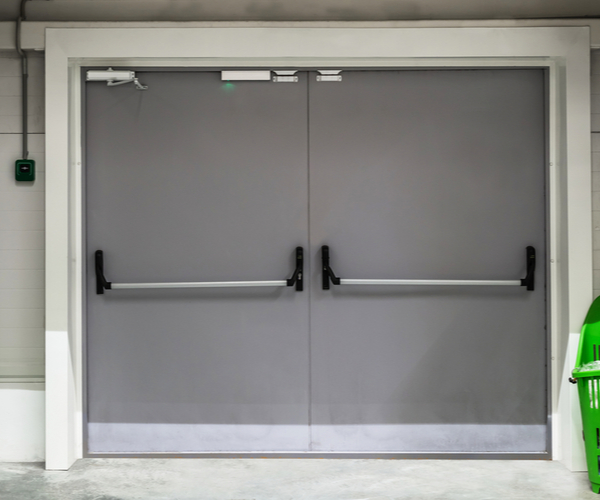To put it simply, a fire door is the first step in a line of defence that separates you from a fire. These doors are constructed of essential components that collaborate to save lives. Depending on how well it was installed, a fire door can mean the difference between life and death.
What are fire Doors?
This is one of the reasons why these doors are subject to such stringent regulations. These doors need to be able to withstand temperatures that are extremely hot. Additionally, they are installed in buildings to prevent smoke from entering other areas.
Fire doors are the obvious choice for fire safety due to their unique characteristics and they are essential to buildings and provide functionality. Consequently, they must comply with the following regulations:
- Accessibility
- Sound
- Ventilation
- Fire Safety
- Efficiency (thermal)
Call Us For A Free Quote – 01245 250 657


What are fire rated door inspections? And why are they important?
A fire door must function properly in the event of a fire, just like any other passive fire protection system. The performance can be affected by even the tiniest alteration to the door or its surroundings. As a result, a fire door should be inspected on a regular basis to ensure that, in the event of a fire, it will work as intended and perform as intended.
Periodic inspections should be carried out at least once every six months, though the first year of occupancy may necessitate more frequent inspections. Additionally, the fire door should be checked more frequently than any other door in the building when it is frequently used. such as once per month or week.
Call Us For A Free Quote – 01245 250 657
A must-needed checklist:
Fire doors are an essential component of any structured Fire Safety Plan and are essential for maintaining building safety. However, fire doors can only be effective if they are properly maintained and ready to serve their intended purpose in the event of a fire. All fire doors need to be inspected on a regular basis to guarantee the safety of a building’s occupants.
Here’s a handy checklist-
- Labels: Every fire door should have a label from the BWF-CERTIFIRE Fire Door Scheme, which is usually on the door’s top edge.
- Leaf: The door leaf ought to be straight and level with the door stop. Check to see that the veneer is still securely fastened in place and that the door does not have any dents, holes, or other damage.
- Frame: Check to see that the frame is securely fastened to the wall, and if there is a planted door stop, make sure that it is also securely fastened. Verify that the door leaf gap always varies between 2-4 mm.
- Seals: If a fire door does not have seals, they should be installed immediately, whether they are intumescent, smoke, acoustic, or a combination of the three. Inside the groove of either the door leaf or the frame itself, all seals must be securely fastened. All seals must be intact and continuous all the way around the frame.
- Hinges: There must be at least three hinges attached to each fire door, and all screws must be securely fastened in place. The screws need to be precisely sized and fitted to the hinge, and they need to be kept free of metal shards and oil leaks. It is necessary to address any signs of wear.
- Threshold Gap: Under the fire door, there needs to be a consistent gap that lets it swing freely without touching the floor. When the door is closed, make sure there is always a gap of 10 millimetres or less between the floor covering and the door.
Some of the most frequently asked questions are:
Who is responsible for the fire rated doors?
In a building, it is the responsibility of the assignedperson to ensure that fire doors are functional. The owner, landlord, or occupier of a commercial property may be the Responsible Person. Multiple Responsible Persons are likely to be present in shared buildings, and they must collaborate to ensure compliance with the Fire Safety Order.
A fire safety expert can be hired by the Responsible Person to provide advice or conduct a fire risk assessment if the Responsible Person is concerned that they do not have sufficient knowledge to complete the task.
How frequently should our fire doors be checked?
In a busy building, every six months or even every three months. Hire a registered FDIS inspector to check your fire doors if at all possible. These individuals have passed an independent competency and knowledge assessment and have earned a diploma in fire doors.
Do fire doors require maintenance?
Fire doors need to be regularly inspected to ensure that they function properly, just like any other product designed to save lives. They should be inspected on a regular basis, just like a fire alarm or smoke detector.
The fire door’s performance may be compromised if it is modified in any way.
How can I determine whether my door is fire-rated?
A fire label can be found on either the top or bottom of a fire-rated door, as well as on the hinge side. Check for any raised surfaces because these labels might be painted over.
Is it a legal requirement to inspect fire doors?
Regular inspections of your fire doors are required by law because there is no other way to ensure that they remain functional. Your company is covered by the Regulatory Fire Reform, which applies to all non-domestic buildings.
